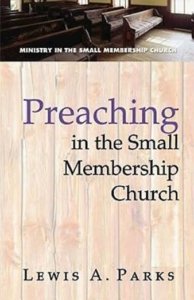Small membership churches thrive on self-reliance, requiring leaders with strong relational skills. Lew Parks writes that preaching in these churches reinforces corporate identity, tells the congregation’s story, addresses key issues, and guides the church toward faithful growth and action.
This article was originally published on May 27, 2009.
Small membership churches have a history of making do without a lot of leadership from persons outside. Many were started by laypersons gathered in homes, sometimes in response to some traveling evangelist’s preaching, but often by their own initiative. Through the years, most small membership churches have been subject to frequent turnover of clergy leadership. Is it any wonder that many of them develop a spirit of robust self-reliance? Any wonder that they are cautious at best and suspicious at worst when the new preacher comes to town?
Some might argue that this is not a problem. They would say that terms like leader and leadership more properly belong to a corporate model of an organization, a model that belongs to larger-membership churches. They suggest that the preferred term describing a pastor in a small membership church is friend, shepherd, or even lover.
There is no doubt that those who provide leadership in a small membership church must know how to lead where relationships are the prevailing currency. They must have people skills. They must know how to read terse remarks and silences. They must be relatively happy to be where they have landed. They must understand “simple” ways of doing things that can turn out to be quite sophisticated exercises in communication, wisdom, and empowerment. This is the flavor of leadership in a small membership church, but it is not a substitute for it. A time comes when the one called to it must be willing to lead, willing to stand back from the intensity and rewards of pastoral relationships to care also for the corporate life of the people of God. One must become not only a friend, shepherd, and lover but also, to use one of the New Testament’s core images for a church leader, anoverseer.
Congregations of different sizes call for different styles of overall leadership. Smaller churches require more of a chaplain or representative minister, larger churches more of a coordinator or even chief executive officer. But preaching is one of those expressions of leadership where there is full equality of challenge and of opportunity. The basic disciplines of leadership by preaching are the same whether the preacher addresses a congregation of 35 or 35 hundred.
Through effective preaching, the pastor of a small membership church can accomplish several important leadership tasks:
Reinforcing the corporate personality of God’s people.
Many preachers preach as if they are trying to connect with individuals. But even the most solitary believer must locate his or her providence in the larger story of the people of God. The preacher in the small membership church can reinforce the corporate identity of the congregation by planning sermon series that address the corporate identity of the congregation, by developing an overt expression of plural address to use when preaching (brothers and sisters, friends, church, saints, or even “you-all”), and by assuming a preaching posture that is appropriate to addressing a group and not just an individual.
Telling the congregation’s story.
The preacher is the chief storyteller of the congregation’s story and knows the value of telling and retelling it on the occasion when most people are gathered and receptive to the storyteller’s spell, that is, the sermon. This is especially valuable to small membership churches, where neglect of history to the point of institutional amnesia is a telling symptom of a lack of corporate self-esteem. A small membership church that cannot tell its own story is prey to a fabricated story told about it from outside by an unfriendly critic. For the sake of building up the body of Christ, the preacher must become a determined student of congregational history. Then in an act of strategic leadership, the preacher must tell that recovered story from the pulpit.
Naming the elephant in the room.
Church leaders must keep in the forefront the congregation’s pressing issues, knowing when to push harder and when to back off. They need to recognize the little games that congregations invent for avoiding the hard work of facing their pressing issues. When they see the congregation getting bogged down in minutiae or creating an obvious scapegoat instead of taking constructive action, leaders must figure out how to cut short such games. The preacher as leader can preach regularly on the congregation’s core values in a manner than invites the congregation to self-examination and holds up the virtue of truth facing and truth telling.
Giving state of the church sermons.
Regardless of its collective plot, every small membership church must advance that plot, must take the next faithful step. With a thoughtful state of the church sermon, a leader can build up corporate identity, name pressing issues, keep first things first, and encourage the congregation to take that step.
 This article is adapted from Lew’s new book, Preaching in the Small Membership Church (Abingdon, 2009). Used by permission. The book is available from the publisher, Amazon, and Cokesbury.
This article is adapted from Lew’s new book, Preaching in the Small Membership Church (Abingdon, 2009). Used by permission. The book is available from the publisher, Amazon, and Cokesbury.
Related Resources
- A New Way to View Vitality in Smaller Congregations by Lewis A. Parks
- Intergenerational Ministry and the Small Church by Brandon J. O’Brien
- Doing Community Ministry in the Small Church by Joy F. Skjegstad
If you would like to share this article in your newsletter or other publication, please review our reprint guidelines.






